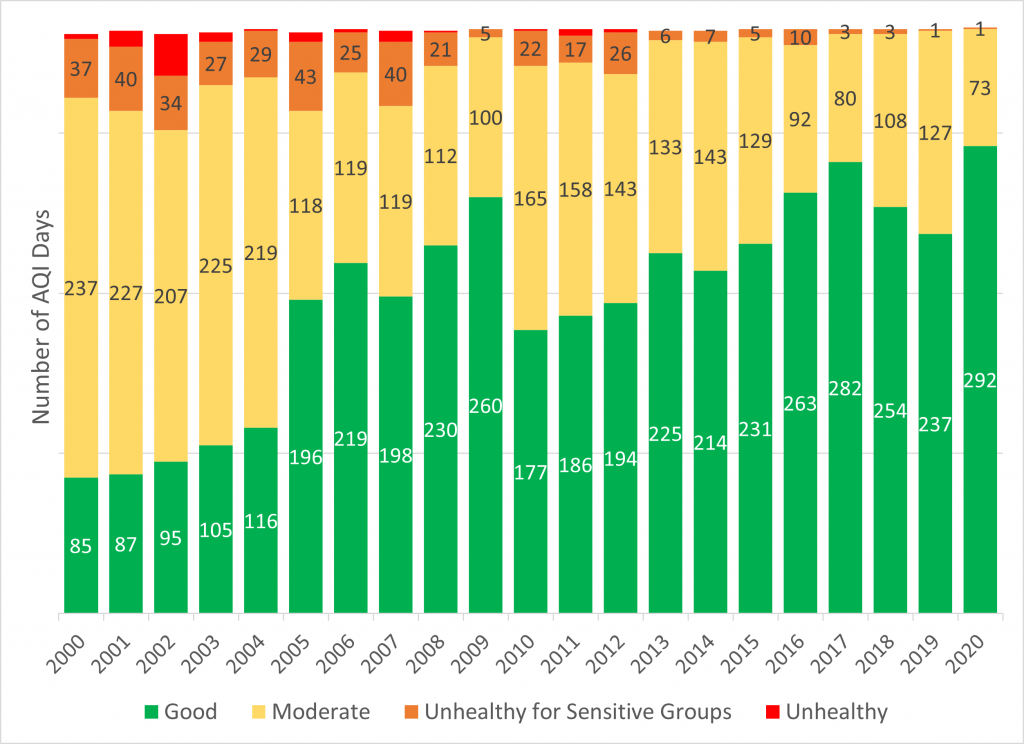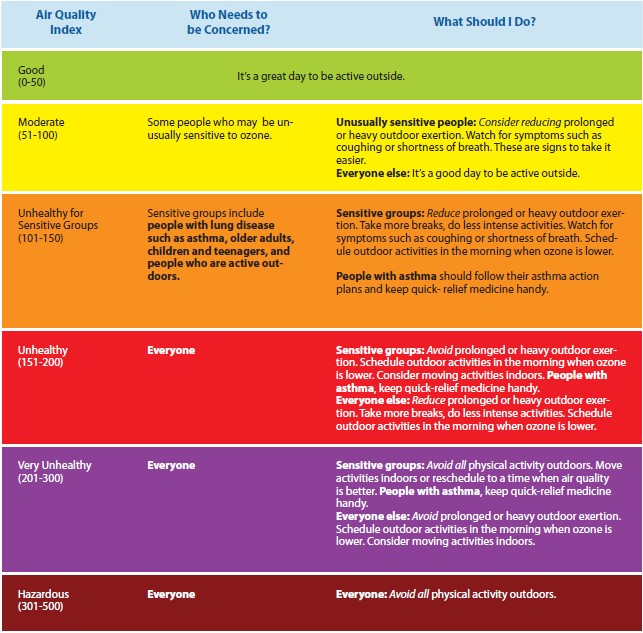We let you know when air pollution levels are high in Central Ohio and how to protect your health and your loved ones. We also work to make the air in Central Ohio safer to breathe through education and by working with local governments and businesses to reduce health-impacting emissions.
Stay Informed: Air Quality Alerts and Forecasts
Get daily air quality information and protect your health. Click here to get Air Quality Alerts or forecasts by email or text.
Neighborhood Air Quality Monitoring Program
MORPC and Franklin County Public Health are partnering to establish an air quality monitoring network that will measure air pollution neighborhood by neighborhood in Franklin County. By gathering more data at the local level, this project will help guide the strategies that go into making the region’s air healthier and easier to breathe. Learn more here.
Air Quality in Central Ohio
MORPC uses the Air Quality Index (AQI) to report daily forecasts and Air Quality Alerts. The AQI tracks pollution levels in the air and tells us if the air is healthy to breathe. On most days, air quality is in the green or yellow range—good days to be active outside. But on several days each year, ozone and fine particle pollution can reach unhealthy levels, pushing AQI levels into the orange range—unhealthy for sensitive groups.
In Central Ohio overall, air quality is improving thanks to local and national initiatives to reduce emissions. The number of good AQI days has been increasing over time while the number of moderate and higher days has been decreasing. The number of unhealthy for sensitive groups and unhealthy days varies from year-to-year due to differences in weather conditions and events like wildfires.

Air Quality Index (AQI)
The Mid-Ohio Regional Planning Commission issues daily forecasts and Air Quality Alerts to keep the public informed of local air pollution levels. MORPC uses the Air Quality Index to report pollution levels. The higher the AQI level, the greater the health concern. When air pollution is expected to reach 101 AQI or above, MORPC will issue an Air Quality Alert for Central Ohio.
Sign up for Air Quality Alerts here.

Ozone Pollution
We monitor and send out forecasts and alerts for ground level ozone pollution levels from March through October. Ground-level ozone pollution is created when emissions from sources such as cars, industry and lawn equipment react chemically in the presence of sunshine. Concentrations of ground-level ozone peak when temperatures are warm, it’s sunny, and winds are light. Ozone is the main ingredient of smog. Learn more about ozone pollution.
Who is at risk?
- Children
- Older adults
- People with lung diseases (asthma, chronic bronchitis, emphysema)
- People active outdoors
- Some healthy people are more sensitive to ozone (possible genetic basis)
Learn more about health impacts from ozone pollution.
Particle Pollution
The Mid-Ohio Regional Planning Commission monitors and sends out forecasts and alerts for particle pollution levels year round. Fine particle pollution (PM2.5) is made of microscopically small solid or liquid particles. Some sources of these fine particles are diesel trucks, buses, power plants, and wood burning fireplaces. Concentrations of PM2.5 often peak during overnight hours when cool air is trapped near the ground and pollution levels build in that layer of air. Particle pollution can also be transported into central Ohio over large distances, such as from distant wildfires, if weather conditions are right. Learn more about particle pollution.
Who is at risk?
- Children
- Older adults
- People with heart diseases (heart failure, coronary artery disease, COPD)
- People with lung diseases (asthma, chronic bronchitis, emphysema)
Air Quality Informational Sheet
Social Media
Graphics and content for Facebook and Twitter
Video
Brochures
Join businesses, local governments and other Central Ohioans in taking clean air actions.
Drive Less
Driving less is better for public health and the economic well-being of Central Ohio. Cars and trucks on our roadways are a dominant source of air pollution. They create almost half of emissions that produce ozone and particle pollution–two health-impacting pollutants that MORPC tracks. And Central Ohio has some of the highest rates of people commuting alone to work in the Midwest.
Instead, try a new way of getting around:
- Gohio Commute lets you explore different ways to commute in Central Ohio
- Bike – CoGo Bikeshare: If you’re looking for a quick and easy way to get around in the downtown area, bikeshare is an excellent solution. For a small fee, you have access to hundreds of bikes that can be used in 30 minute increments. You can use the Columbus Metro Bike Map to help find your way.
- Bus – COTA and Delaware County Transit
- Vanpool – Gohio Commute Vanpool
When driving is necessary, consider a fuel-efficient vehicle – SmartWay Certified Vehicles
For Governments and Businesses:
- Contact Gohio Commute staff for resources and support to implement a commuter plan for your employees
Be Idle Free
Turn Your Key, Be Idle Free!
What wastes gasoline, costs money, produces pollutants, and yet doesn’t get you anywhere? Idling! And yet, every year, Americans waste 3 billion gallons of fuel by idling their vehicles.1
For Governments, Organizations, and Businesses:
Make your operations more economical and sustainable by going Idle Free. We provide free support services to local businesses, organizations, and governments interested in adopting an Idle Free policy. This includes sample Idle Free policies, support from MORPC staff in tailoring a policy to your needs, materials to distribute to employees, and free parking lot signs for those adopting an Idle Free policy. Click here for more information and a sample policy.
Contact Brandi Whetstone or call at 614-233-4174 for further information.
More Actions
- Keep your car in good repair
- Refuel your car after sunset on Air Quality Alert days
- Plant and care for trees
- Work from home
- Postpone mowing with gas-powered mowers on Air Quality Alert days
- Switch to electric or hand-powered lawn equipment
- Conserve energy
- Avoid burning, including grilling and burning trash
MORPC recognizes and supports the United States Environment Protection Agency’s (EPA) Burn Wise initiative to inform citizens to burn the right wood, the right way, in the right appliance in effort to decrease air pollution.
Safety and Health Effects of Wood Smoke
The Burn Wise program encourages residents and communities to implement safe burning practices to improve air quality. Please refer to the following guidelines for more information:
Who is at Risk for Wood Smoke?
Particle pollution is the main component to wood smoke, and exposure to those particles can result in poor air quality.
Wood smoke can affect everyone. However, populations at the most risk include children, teenagers, older adults, those who suffer from lung disease (asthma & COPD), and/or heart disease, outdoor workers, and those of low economic status.
COVID-19
Those who have been diagnosed with COVID-19 or are recovering could face increased health risks from exposure to wood smoke this fall. Exposure to wood smoke can also lead to an increased risk for developing respiratory infections, like COVID-19. Learn more by visiting the following:
What You Can Do
- Check the air quality and wind direction before you burn.
- Burn small, hot fires – do not let them smolder.
- Have your stove inspected before burning season.
- Only burn seasoned wood – never trash.
- Follow these Best Wood-Burning Practices.
Additional Resources







